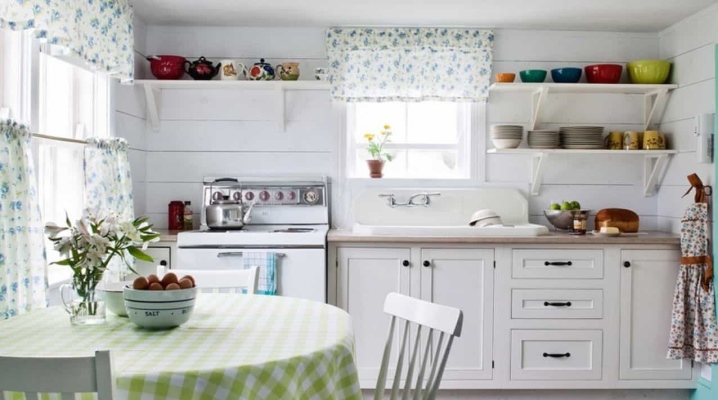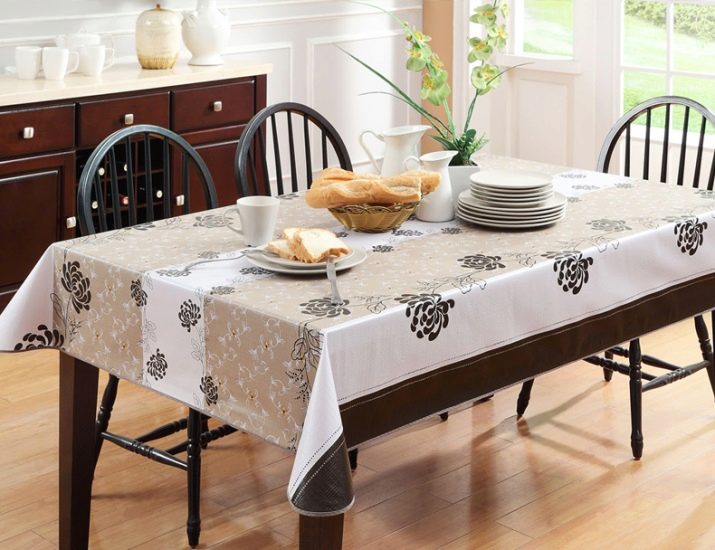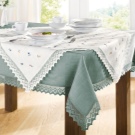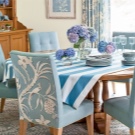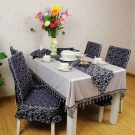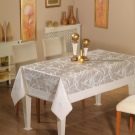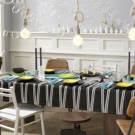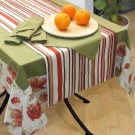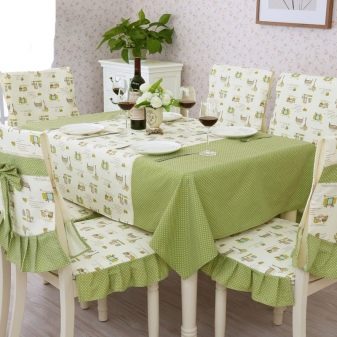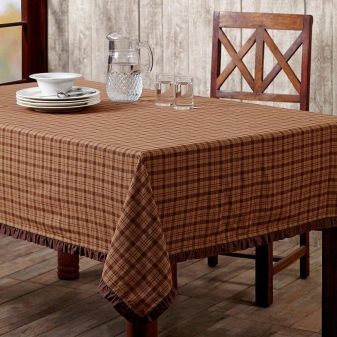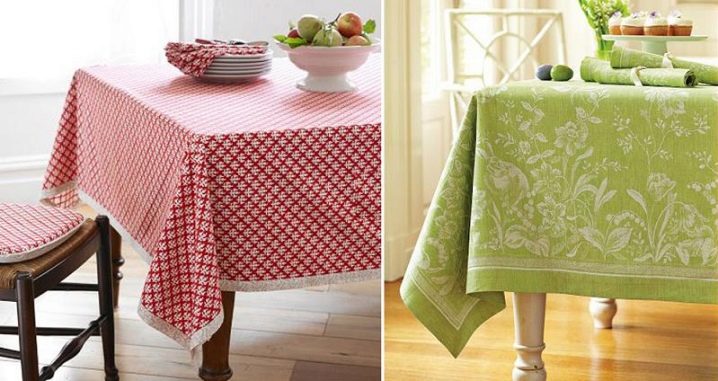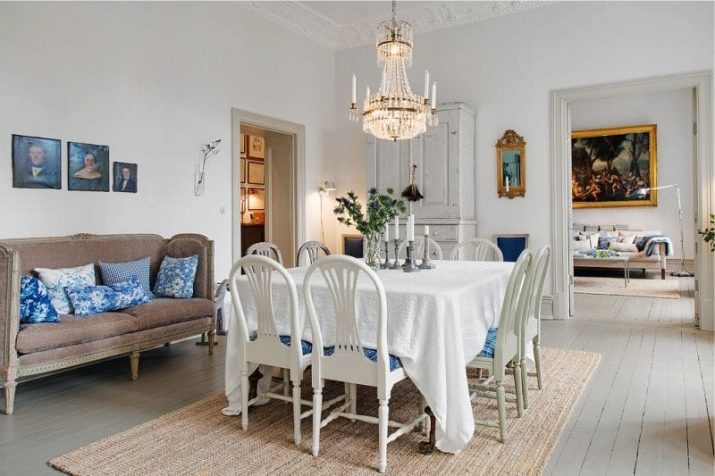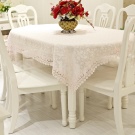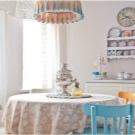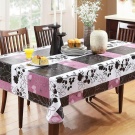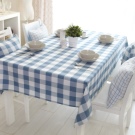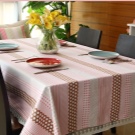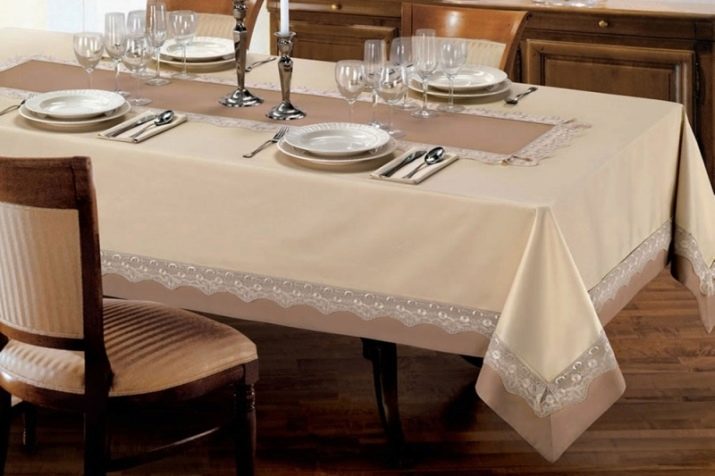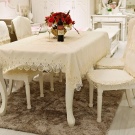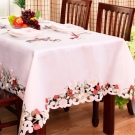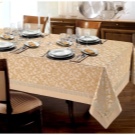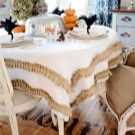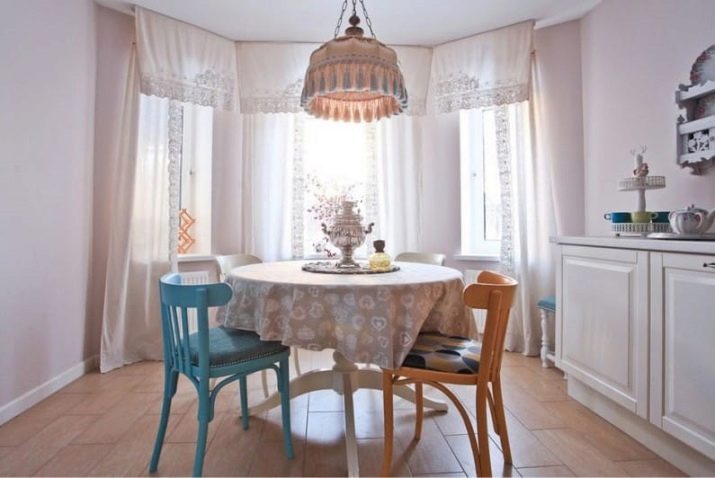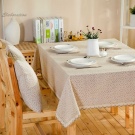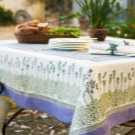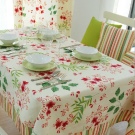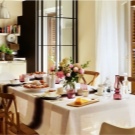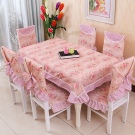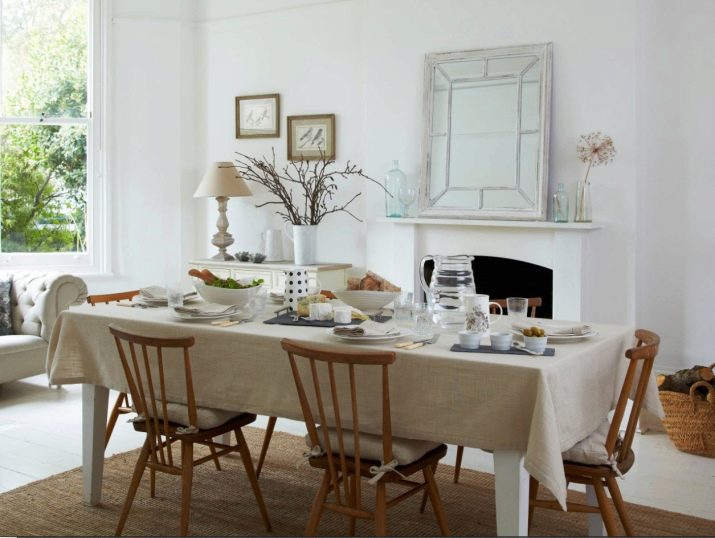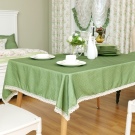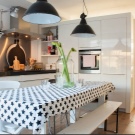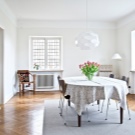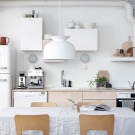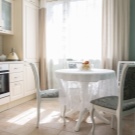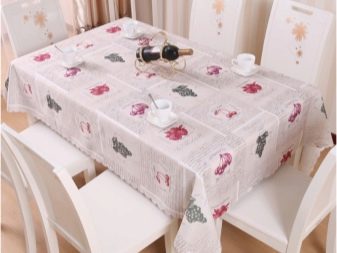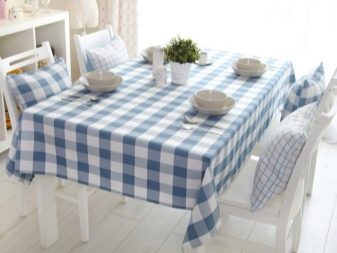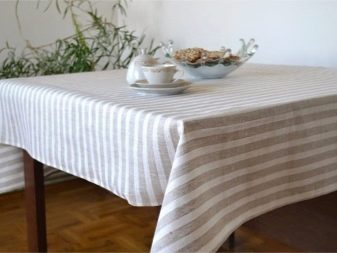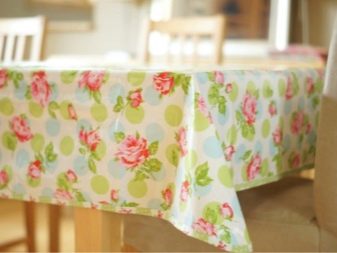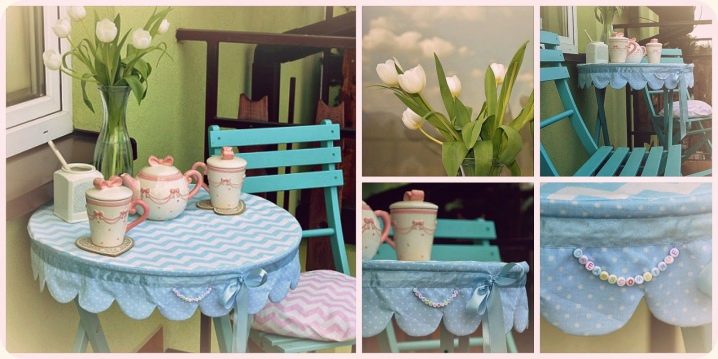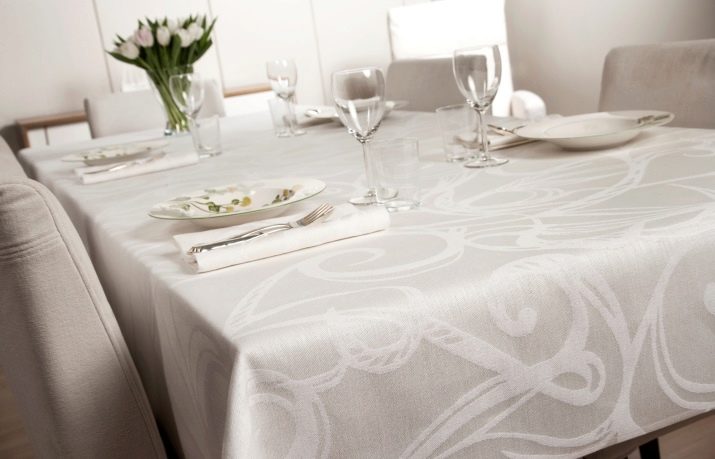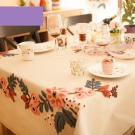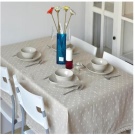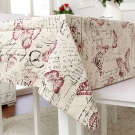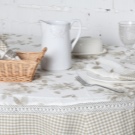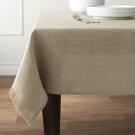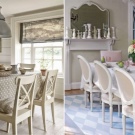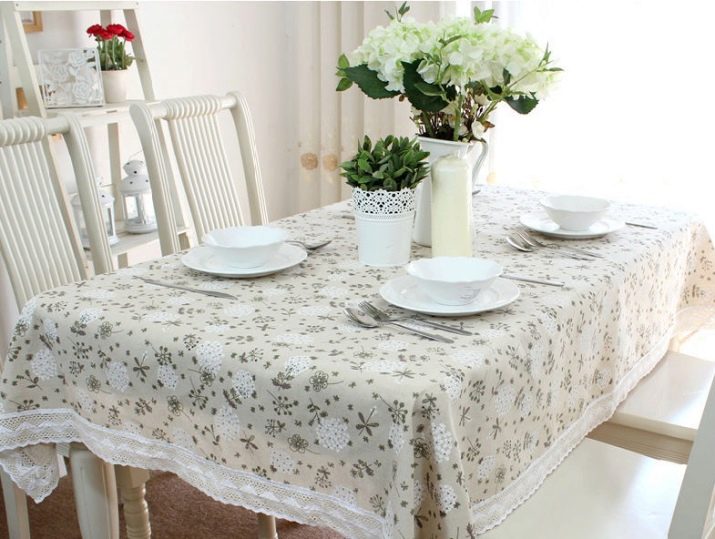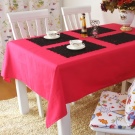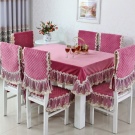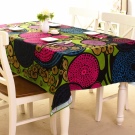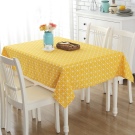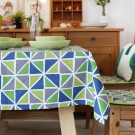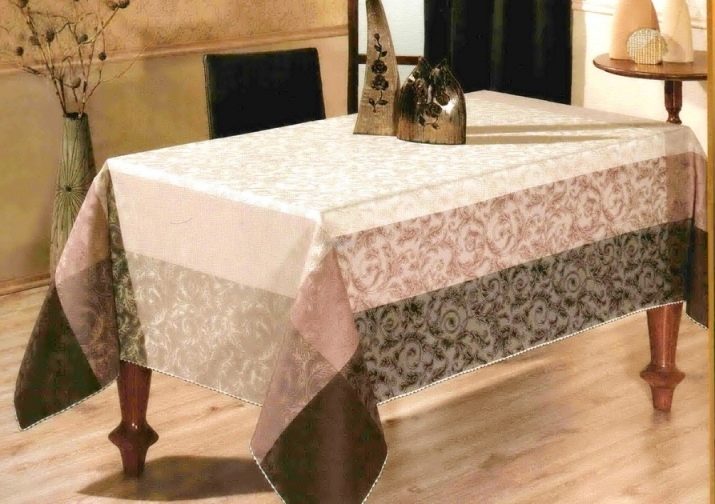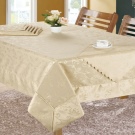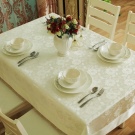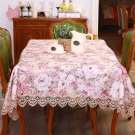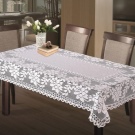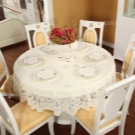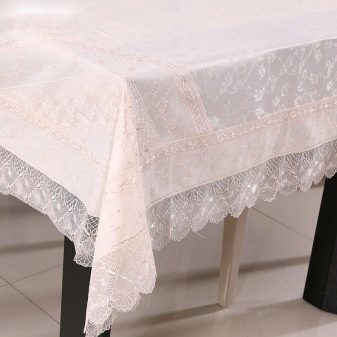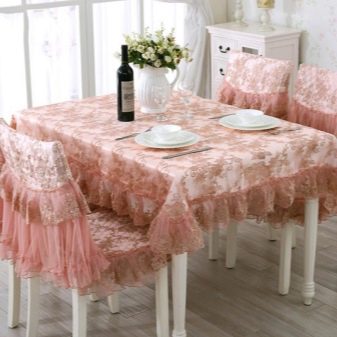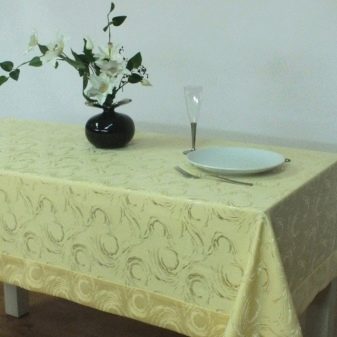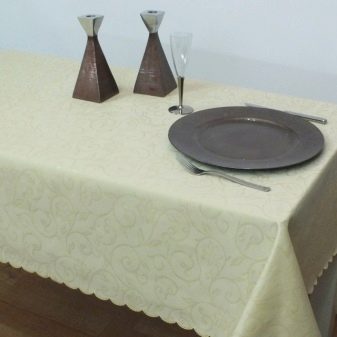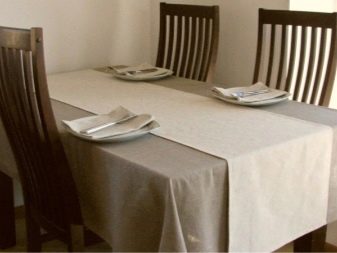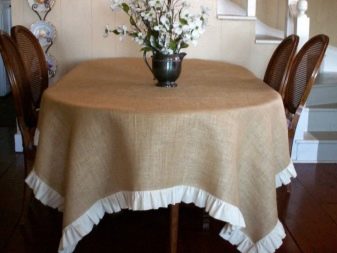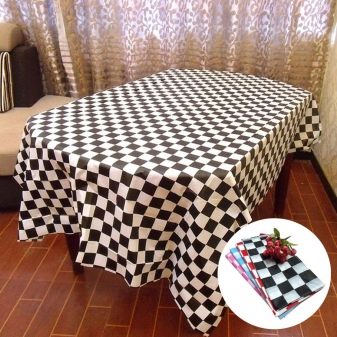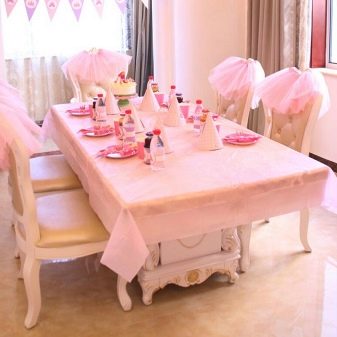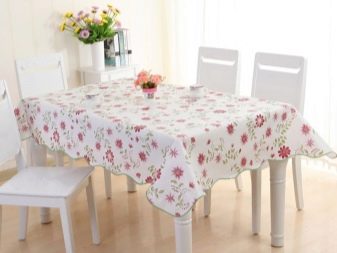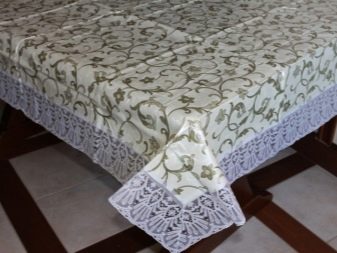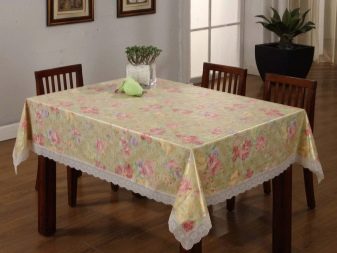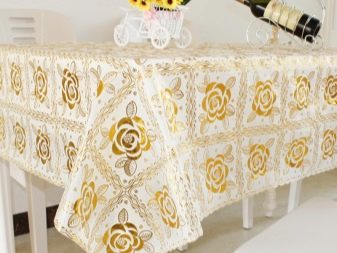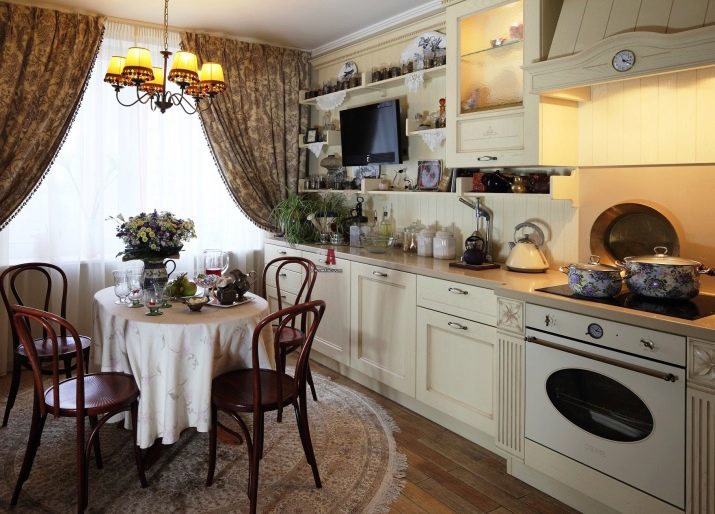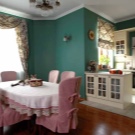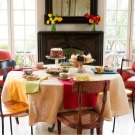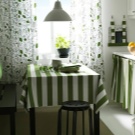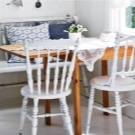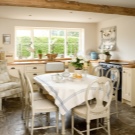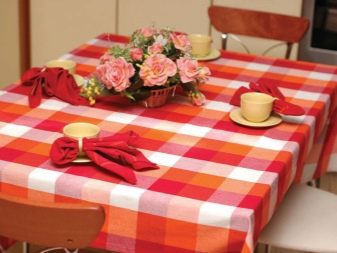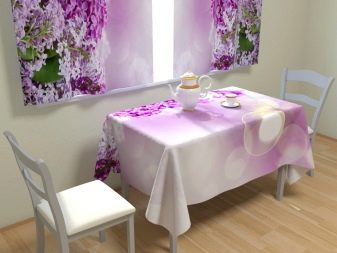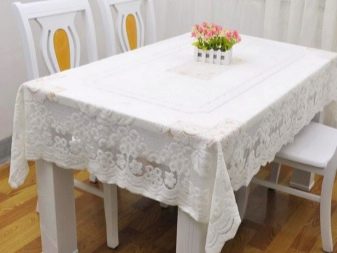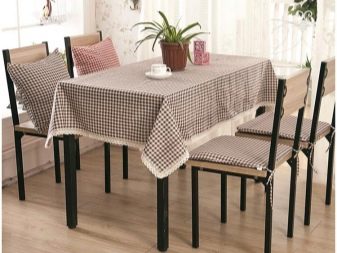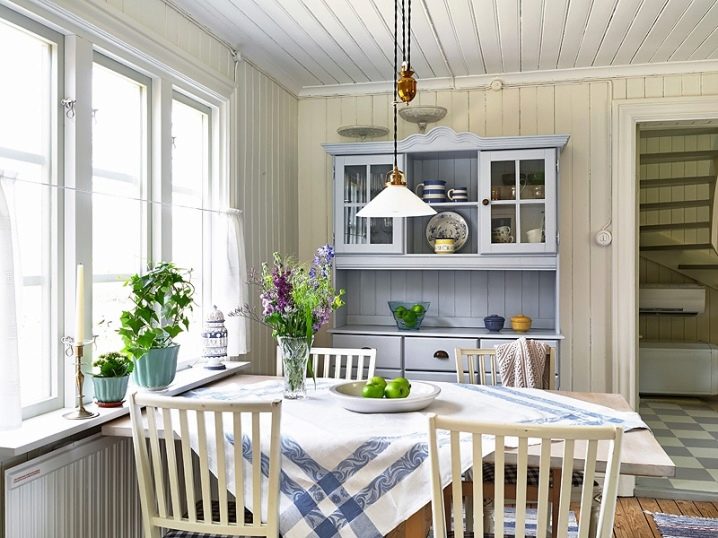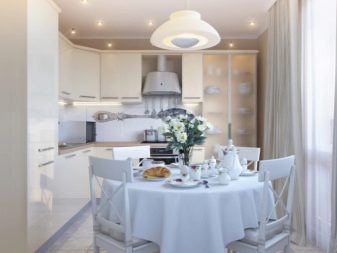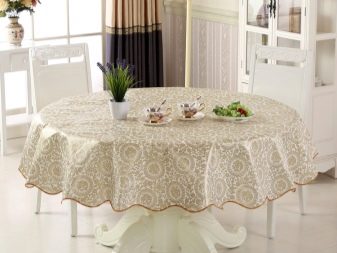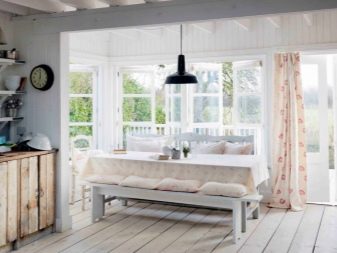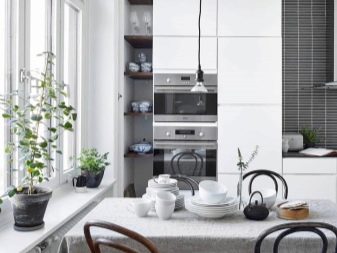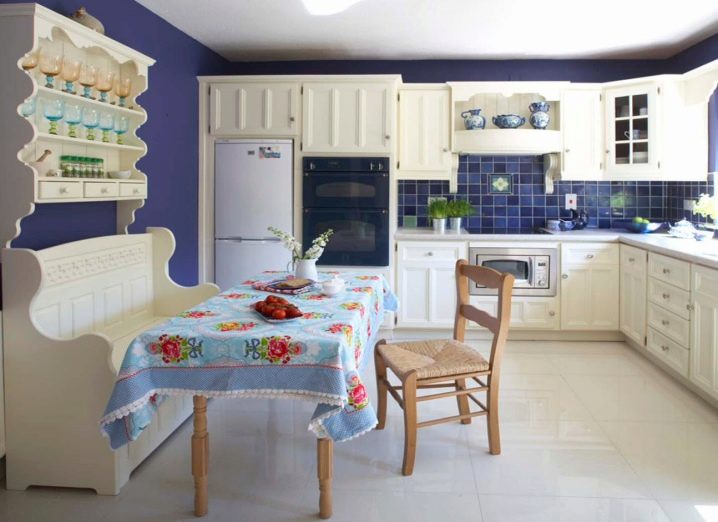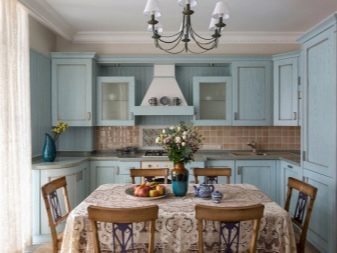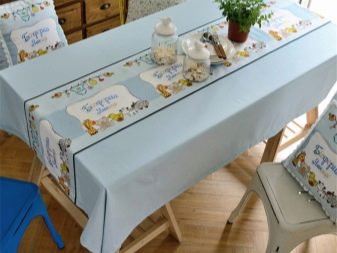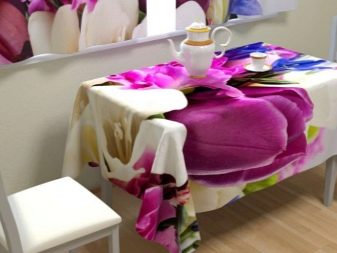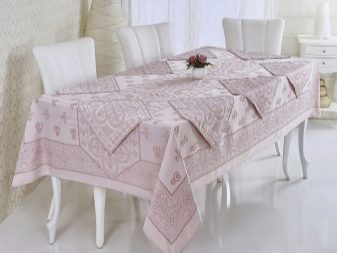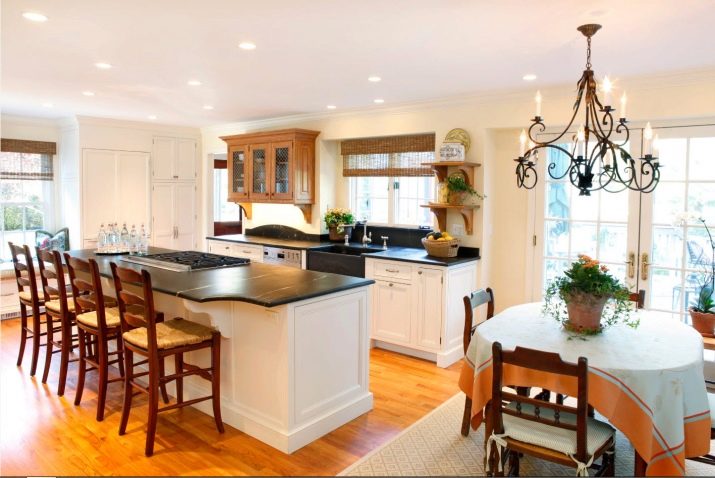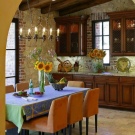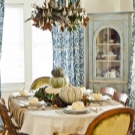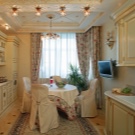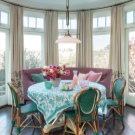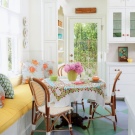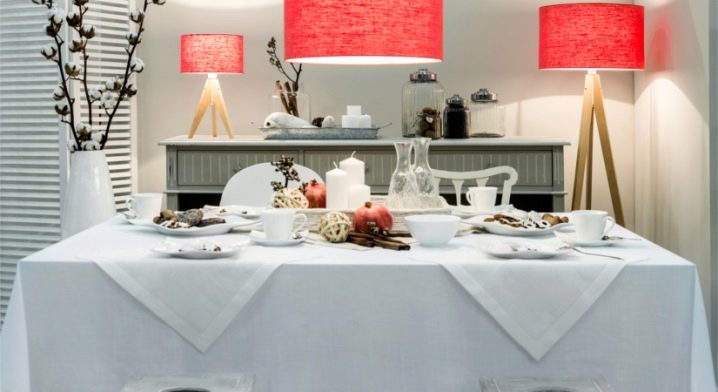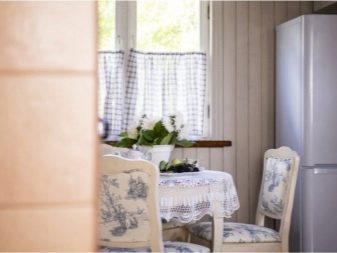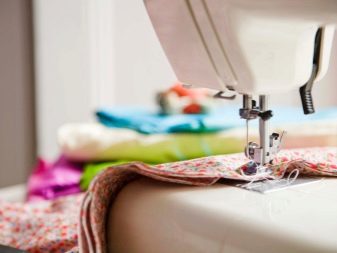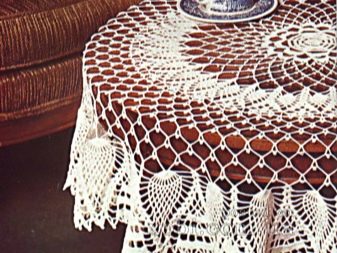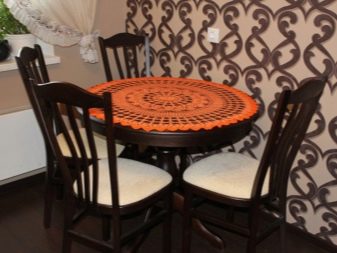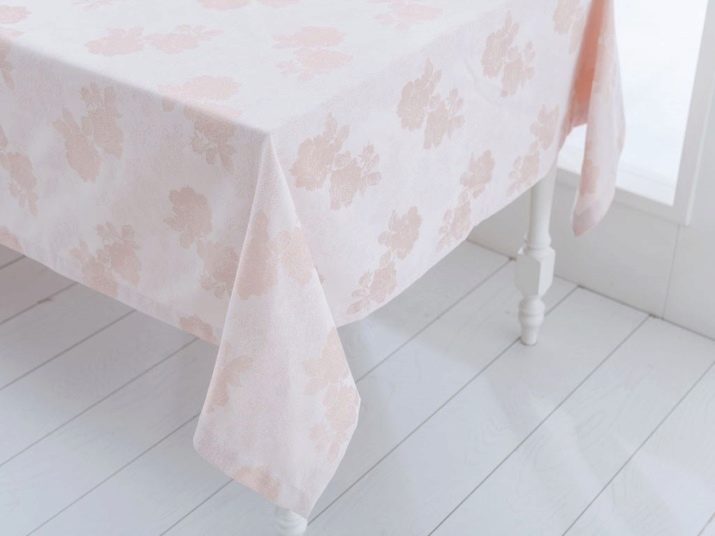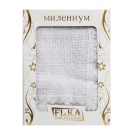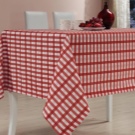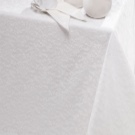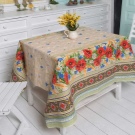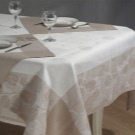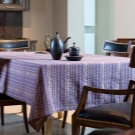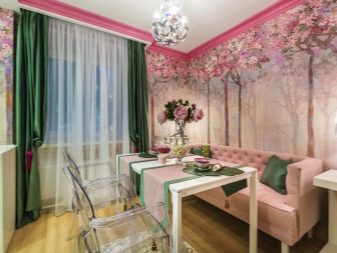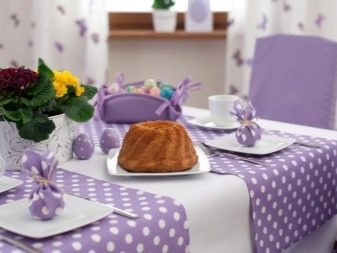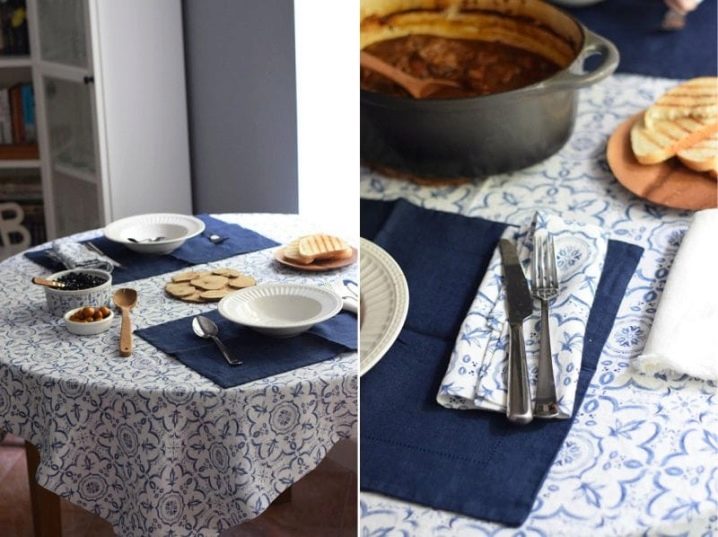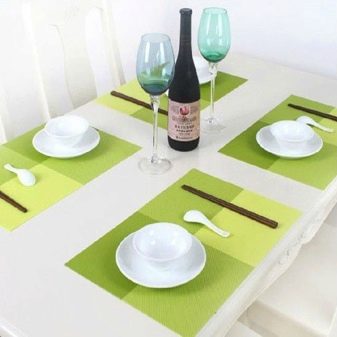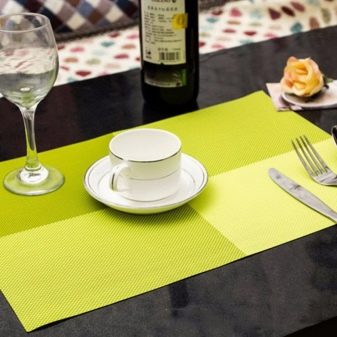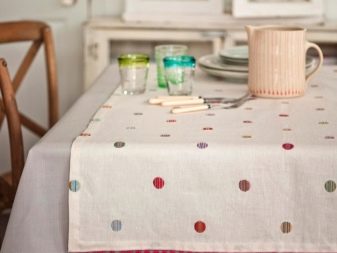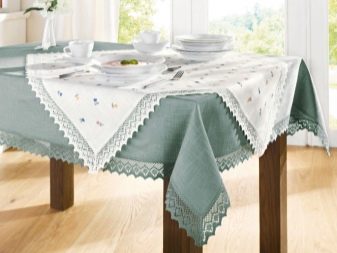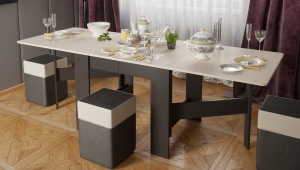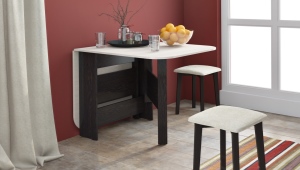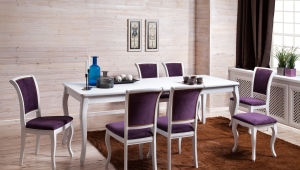Cloth on the table for the kitchen
Features and benefits
In the old days, women considered it obligatory to have a tablecloth on the table, without it it was considered indecent to meet guests and sit them down at the table. Now the table with a tablecloth is most likely associated with a holiday table. Many people are not sure whether such a purchase in the house is necessary at all, some may consider it an old-fashioned phenomenon, others simply do not see the need for such spending.
In fact, there is much more reason to lay a tablecloth, in addition to decorating the table for a holiday. It will not only give the interior a more aesthetic look, but also hide the flaws on the tabletop or legs, create a solid image of an inexpensive table. It will protect the table from external adverse effects: even the most durable table will not like it if you periodically put hot dishes on it, spill drinks and drop appliances. Also, the correct tablecloth should muffle the sounds from the dishes and not allow the devices to slide on the table.
Modern manufacturers offer a huge selection of styles, materials, shapes and styles of tablecloths. Everyone will be able to decorate the table to your taste, taking into account the features and other furnishings.
Kinds
The most important classification is based on the shape of the table. Four types of tabletops allowed to create four forms of tablecloths: square, rectangular, round and oval.
Tablecloths are separated and according to their purpose. Festive - elegant and solemn, made of expensive materials. More restrained styles have a classic color, embroidered patterns adorn the sides or center. Brighter ones have a thematic pattern in accordance with the event being celebrated. The length of the festive tablecloth should be large: hang down by 25-40 centimeters, sometimes even the length can reach the floor. The color can be either a classic white or any other color or color combination, the main thing is that these are cheerful colors that create a festive atmosphere in the house.
Not quite a festive guest tablecloth. This is such an interior decoration that can be laid on a laid out table when many guests arrived.This tablecloth is designed for special occasions, so it will definitely be different from everyday and look more solemn, but in style for such occasions it is better to choose something neutral.
Casual tablecloth should be made from practical materials that are easy to wash or wash. It should not be fanciful and too bright. In length, it is also the shortest of all. Its main functions are to protect the table and, possibly, to hide existing defects.
Cloths made of cloth are difficult to clean, any stain can be removed only with the help of washing, and sometimes dry cleaning. This is a time consuming and expensive process. Therefore, water repellent tablecloths, for example, oilcloth cloths, can be used as everyday ones. They are easy to clean, protect the table from accidentally spilled liquids, they are very cheap. However, the oilcloth is a short-lived material, easily deformed by the effects of many reasons. More resistant and durable - the so-called polypropylene thermoscloths. There is a wide variety of thermocouples with all sorts of drawings, there are simple transparent thermoscloths, which lie almost imperceptibly on the table and serve to protect the table top.
If you still want to have a fabric everyday cloth, then water-repellent properties also have fabrics impregnated with Teflon. The principle of Teflon tablecloths is that they are created on the basis of the main fabric, natural and synthetic, and a layer of Teflon impregnation is added to it. With an increase in the amount of impregnation, useful properties are added to the tablecloth, such as water and dirt repellency, resistance to oils and even absorption of liquid inside. At the same time to the touch, the density of Teflon is invisible. True, Teflon will damage or peel off over time and lose its beneficial properties. An alternative option for a water repellent fabric tablecloth is laminated cotton.
In order that the tablecloth did not slip and that small children could not tear it off along with all the contents on the table, they invented special tablecloths on an elastic band. They are hemmed to the size of the tabletop, tightly held and create an interesting image in the interior.
Materials
In modern stores there are no problems with the choice of tablecloths, many designs, a large selection of shapes and sizes and, of course, a variety of materials from which they are made.
Traditionally, the most common materials for the manufacture of tablecloths - different types of natural or synthetic fabrics. Linen fabric looks very expensive and elegant, gives lightness to the interior of the room, but, unfortunately for housewives, it easily gets dirty, and almost any stain will be very difficult to remove. It is better to use linen fabric in rare cases, for example, on special holidays or when infrequent guests arrive.
Cotton fabrics can already be impregnated with Teflon or acrylic to obtain waterproof properties. The main disadvantage of cotton fabrics is that they sit down after washing. This feature must be considered when determining the required size of the tablecloth. Cotton table decoration is quite a budget, eco-friendly and at the same time practical option for both festive and everyday table decoration.
Jacquard tablecloths are suitable as a table decoration for a holiday. This material is expensive, but it is dense and can carry a lot of washes. However, jacquard care is not easy, and to keep the fabric whole, you need to follow all the rules when cleaning and ironing.Jacquard fabrics are distinguished by the fact that they can be put both on the front and on the wrong side, the design on the wrong side can be even different in shade, but look quite solid enough to decorate the tabletop.
Even more expensive, but looking more than luxurious material - silk. Such fabrics are very impractical, they are easy to deform and difficult, and sometimes impossible, to return to their former appearance and shape. Most often, silk fabrics are used as an addition to the dense material that lies on top.
Synthetic materials, such as polyester, make it easier for housewives to take care of the fabric, since they practically do not need to be ironed. They absorb moisture, can withstand a lot of washes and do not crumple when used. At the same time synthetic fabric is easy to damage, it quickly fades. The main danger of synthetics is that it is very flammable, so you should be careful with candles on this fabric.
Now in vogue tablecloths made of burlap. Simple material that looks very stylish, including at festive events. Also valuable is everything that is done by hand.As for tablecloths, they are often decorated with crocheted elements. A fully knitted canvas can also decorate the table, but will only perform decorative functions in the interior.
The most budget option for the table design is to buy a paper tablecloth. This is not necessarily a one-time decoration; some paper tablecloths can be washed. Often they are sold in rolls, due to which such a track is easy to lay and assemble back. The main disadvantages: fragility and permeability.
Already for a long time the housewives remain in demand vinyl tablecloths. They do not absorb liquids, have a variety of beautiful patterns, do not sit down and do not fade during washing, serve for a very long time, and are cheap. Although vinyl is easily deformed with cutlery, small patterns are difficult to remove from contamination, as well as frequent friction, it can lose color. Silicone tablecloth I collected all the advantages of vinyl fabrics and added my own to them. It is transparent, and therefore does not hide a beautiful tabletop, but also protects it from water and hot dishes, durable and very inexpensive. Often has a glossy and embossed side,therefore, you can always turn it over and get a new look. But such a litter performs more protective, rather than decorative functions in the kitchen.
Formerly, tablecloths made of oilcloth were very popular, it does not let water to the table and is very cheap, but is afraid of exposure to high temperatures. Not so long ago, PVC tablecloths appeared, that is, made of high-temperature resistant plastic. The surface can be both smooth and textured. The color can be transparent or with any pattern that does not fade and does not wear off from frequent friction. Cleaning PVC tablecloth is easy with a regular sponge. The material is environmentally friendly, it does not swell and does not melt from even very hot objects. This is a great economical option for the modern design of the table for every day.
Colors and decor
The color of the tablecloth depends on its purpose and interior features in the room. For banquets and other special occasions, as a rule, they stretch the classic white fabric. For holidays at home, a bright monophonic or with a thematic pattern would be an excellent option.But perfectly fit into the festive atmosphere and snow-white tablecloth with elements of embroidery, appliqués or patterns along the edges. A universal tablecloth for all holidays can be a canvas of basic colors with soft patterns.
For everyday tablecloths, neutral colors are most suitable, for example, cream, gold or chocolate, but the color scheme of the room interior plays a decisive role. The color of the tablecloth should be similar or well combined with the main color of the surrounding furniture. When choosing a color, the rest of the textiles in the kitchen will be a good guide: curtains, upholstery of chairs and sofas, napkins, etc.
Warm shades like red, orange and yellow colors add comfort to the house and are perfect for decorating the table for the holidays. The cold shades of blue and green have a calming effect on the household members sitting at the table. A table decorated in light sober colors of almost any color will look more harmonious in most interiors. At the same time, thermoscloths with a pattern, and manufacturers offer them for every taste and color, also look appropriate for everyday use.
The size
The table is, as a rule, a long-term thing, so it is quite possible to buy several tablecloths for it for all occasions and change them periodically. The most important thing is to know the right size. Everyday tablecloth should hang no more than 20 centimeters, festive - can be much longer. Therefore, the length and width or diameter of the table top must be added from 40 to 80 centimeters, depending on the purpose of the purchase. With these measures, you can go to the store or studio and select the necessary table decoration with the correct size.
It is not necessary to repeat the shape of the tablecloth and the shape of the tabletop, there are many options to cover the table creatively. On a rectangular table it will look beautiful square, located on a diagonal of any size or an inverted rectangle with a width less than the length of the table at least 40 centimeters. On a square tabletop you can also lay a rectangular canvas with open sides of about 10 centimeters.
Round table is perfect square decoration, as long as the corners do not touch the floor. On an oval tabletop, it is permissible to similarly lay a rectangular tablecloth, not forgetting the corners, or an inverted rectangle, opening the tabletop 20 centimeters on each side.
How to choose
In order to choose the right tablecloth, it is necessary, first of all, to clarify for what purposes it is needed. Festive tablecloths are often woven, made of expensive materials, brighter and more elegant. Everyday - neutral and very practical.
The second sign on which you need to properly arrange the table - the required size and shape. It is best to measure your table in advance and calculate how large the canvas should be, taking into account the hanging sides and material properties.
Next you need to decide on the color and design. This is a completely subjective decision, the table with its color scheme can stand out in the interior of the kitchen or balance the overall atmosphere. Often, the colors are chosen for dishes, for example, if a drawing is applied to the tablecloth, then only one-colored dishes will do. It is necessary to take into account the style of the interior, because not every drawing will fit any style decision in the room.
Then you need to choose the material from which the tablecloth is made. It depends on the available budget. Inexpensive options are paper, oilcloth, PVC, silicone and vinyl. Tablecloths of all types of fabric are more expensive and difficult to clean, therefore they are suitable only for special occasions.
The last thing you should pay attention to when choosing is additional materials. All accessories must be completely in harmony with the main decoration on the table.
How to do it yourself
If it is difficult to find in the store exactly the option that fits to the interior of the kitchen, you can sew a tablecloth with your own hands. First, you need to measure the tabletop and think about exactly how the finished decorated table will look like, then find the desired fabric and colors in the store, make a pattern according to the counted sizes. We must not forget that the pattern will be a few centimeters more than the desired length and width.
You can also add your own elements to the purchased finished tablecloth, for example, decorate the corners with themed embroidery or sew lace along the edges of the fabric to the overhang. In this case, you need to buy a tablecloth a little smaller in size so that the hanging sides are not too long.
For those who like to knit a crocheted tablecloth can be a great solution. It can be used as the only one on the table or as an additional over the main fabric tablecloth.
Overview of the best manufacturers
Tablecloths are sewn in all countries, but not every country makes it really beautiful and of high quality. This is evidenced, above all, by the company's image and customer reviews. One of the most sought-after manufacturers in Turkey are the Millennium, Pavia, Le Velay, Issimo brands and many others. Of the European manufacturers, the most famous are made in Italy (brand Runo) and Germany (Friedola). In Ukraine, the Perrini brand is respected, in Belarus - Belarusian flax. In Russia, perhaps, the most popular and sought-after tablecloth manufacturer is the Yakovlevskaya Manufacture. High-quality products for the design of the table are also produced by Polish manufacturers.
Interesting solutions in interior design
Diversify and revitalize the look of the table can be contrasting lines. Not so long ago, it became fashionable to place a narrow runner over the tablecloth - a runner. It can be put along the table to put on it the main dishes, candles and vases with flowers. You can place runners across the table, then it is appropriate to put plates and appliances for each guest on them. In this case, only the runner will have to be washed after the meal, and not the tablecloth itself.
Also, a special item on the table can be a special dimming. Most often they are made of some durable material: bamboo, cork, wood, heat-resistant plastic. The bugles will also protect the main fabric from stains, change the dull interior and highlight the place of each guest at the table.
Some housewives spread beautiful napkins instead of tablecloths on the table. For example, felt napkins look interesting. The napkin should be slightly smaller than the tabletop, because the felt is too thick and cannot hang. The advantage of felt is that it does not transmit heat and is resistant to high temperatures, and therefore protects the tabletop even better than any other fabric tablecloth.
A stylish solution would be the combination of two fabric tablecloths. This is done not only to protect the expensive material from below, but also in order to revive the interior. The second tablecloth is most often made of a lighter material, it should be matched in color with the first, the tone can be both contrasting and close to the tone of the bottom fabric.
